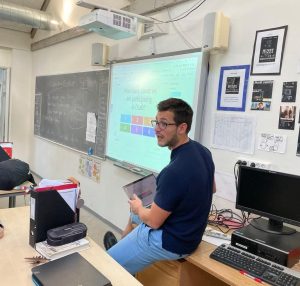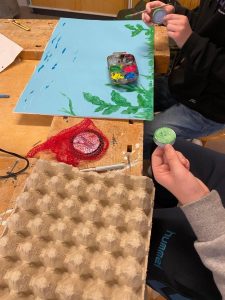Day 1:
 We had a bottom-up teaching method which seemed to work pretty well in the classroom. The beginning of the lesson went smoothly with a correct framework. The students seemed to find it more engaging to have to search for themselves about other countries and their environmental issues. However, when the students had to go on an outing, we (students) weren’t aware of the routes we could take and therefore had to rely on the teachers and pupils to guide us in the right direction. The pupils were also going at their own speed and didn’t have enough structure to keep them together.
We had a bottom-up teaching method which seemed to work pretty well in the classroom. The beginning of the lesson went smoothly with a correct framework. The students seemed to find it more engaging to have to search for themselves about other countries and their environmental issues. However, when the students had to go on an outing, we (students) weren’t aware of the routes we could take and therefore had to rely on the teachers and pupils to guide us in the right direction. The pupils were also going at their own speed and didn’t have enough structure to keep them together.
 Day 2: It was the day we had the pupils build from the trash they found. The shop we created worked really well, pupils were very much into the whole gamification of the market to better their art made of trash. However, a few pupils did not enjoy the whole “building our own art” idea and would rather talk and mess around with other groups. Therefore, we needed a teacher to be omnipresent at the table to make sure they were on the right track. The rest of the students were letting their imagination go wild and kept on developing their idea from brainstorm to final product.
Day 2: It was the day we had the pupils build from the trash they found. The shop we created worked really well, pupils were very much into the whole gamification of the market to better their art made of trash. However, a few pupils did not enjoy the whole “building our own art” idea and would rather talk and mess around with other groups. Therefore, we needed a teacher to be omnipresent at the table to make sure they were on the right track. The rest of the students were letting their imagination go wild and kept on developing their idea from brainstorm to final product.
 Day 3: Day 3 was postponed and implemented at a later date than originally planned. Therefore, we had to postpone it to a later date and have a 3 hours session instead. This led to a change of plans and shortening our lesson to fit the 3 hours we had with the class. The creative piece the students had to write was a bit more difficult as it is something going a bit outside of their field of learning. Also, two of our students could not take the task seriously, therefore we made a deal to go outside and write to keep their engagement up. This worked well.
Day 3: Day 3 was postponed and implemented at a later date than originally planned. Therefore, we had to postpone it to a later date and have a 3 hours session instead. This led to a change of plans and shortening our lesson to fit the 3 hours we had with the class. The creative piece the students had to write was a bit more difficult as it is something going a bit outside of their field of learning. Also, two of our students could not take the task seriously, therefore we made a deal to go outside and write to keep their engagement up. This worked well.
Overall: We had some schedule mismatch on day 1 knowing when the students were supposed to leave, to know whether or not they can attend our online meeting with the other countries. We also had difficulties with the beginning of the day, when did we properly start the lesson. However, these issues were fixed for day 2 and 3. Finally, we believe everyone would benefit from having the international days closer to each other (a shorter time-span) so we would not have to remember what’s been going on and have the pupils more focused on the whole idea of international days and what they are meant for.
